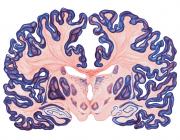Functional imaging of the human lateral geniculate nucleus and pulvinar.
Publication Year
2004
Type
Journal Article
Abstract
In the human brain, little is known about the functional anatomy and response properties of subcortical nuclei containing visual maps such as the lateral geniculate nucleus (LGN) and the pulvinar. Using functional magnetic resonance imaging (fMRI) at 3 tesla (T), collective responses of neural populations in the LGN were measured as a function of stimulus contrast and flicker reversal rate and compared with those obtained in visual cortex. Flickering checkerboard stimuli presented in alternation to the right and left hemifields reliably activated the LGN. The peak of the LGN activation was found to be on average within +/-2 mm of the anatomical location of the LGN, as identified on high-resolution structural images. In all visual areas except the middle temporal (MT), fMRI responses increased monotonically with stimulus contrast. In the LGN, the dynamic response range of the contrast function was larger and contrast gain was lower than in the cortex. Contrast sensitivity was lowest in the LGN and V1 and increased gradually in extrastriate cortex. In area MT, responses were saturated at 4% contrast. Response modulation by changes in flicker rate was similar in the LGN and V1 and occurred mainly in the frequency range between 0.5 and 7.5 Hz; in contrast, in extrastriate areas V4, V3A, and MT, responses were modulated mainly in the frequency range between 7.5 and 20 Hz. In the human pulvinar, no activations were obtained with the experimental designs used to probe response properties of the LGN. However, regions in the mediodorsal right and left pulvinar were found to be consistently activated by bilaterally presented flickering checkerboard stimuli, when subjects attended to the stimuli. Taken together, our results demonstrate that fMRI at 3 T can be used effectively to study thalamocortical circuits in the human brain.
Keywords
Journal
J Neurophysiol
Volume
91
Pages
438-48
Date Published
01/2004
ISSN Number
0022-3077
Alternate Journal
J. Neurophysiol.
PMID
13679404

